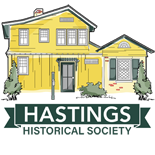
by Richard Lovejoy

Recently Michelle Bohuniek, a former Hastings resident, asked us for any information we might have about her former residence at 357 Mt. Hope Boulevard. Specifically, she was interested in what we knew about a tea room that she had heard operated in her house and served customers of the New York & Putnam railroad.
What was known as the “Old Put” ran from Brewster to Sedgewick Avenue in the Bronx, and was later transformed into the South and North County Trailway, a walking and biking trail. Its Hastings stop was Mt. Hope station, which was located on the east side of the Saw Mill Parkway, about 100 yards north of Ravensdale Road. An old sidewalk a few feet from Michelle’s house at 357 Mt. Hope used to lead to a pedestrian bridge to Mt. Hope station.
I grew up a few blocks from Michelle’s house, and remember seeing freight trains go by on the Putnam line from my front porch as a small child. Lately I’ve been interested in how the existence of the commuter rail line might have influenced the day-to-day character of the neighborhood in which I grew up. Stories have been passed down over the years of a tea house in the vicinity, but very few details were known.
At the time Michelle contacted us, the Hastings Historical Society was aware of a tea house near 357 Mt. Hope, but we didn’t know its exact location. In our records are two vintage postcards depicting a stone bungalow captioned as a “tea house opposite Mt. Hope station,” some brief snippets in the Spring 1990 Hastings Historian, and a “Then and Now” article in The Enterprise from several years back. It was possible that the postcards depicted Michelle’s house in a more primitive state, but there was no decisive evidence to support this, or any other theories we had.
Would it be possible to uncover other clues or evidence for the existence of this tea house? Could we possibly learn its exact location, the dates of operation, its proprietors, how it was used, or even what it looked like inside? Was Michelle’s house actually the tea house in the postcards?
Fortunately, the answers to almost all of these questions, and some we didn’t think to ask, were discovered. After researching maps, property records, aerial photographs and newspaper article clippings from the time period, we now have a clearer picture of the tea house, as well as other businesses in the area, the people who ran them, and when they operated.
HUDSON P. ROSE & HUDSON HEIGHTS
In the early 1900s, farmland owned by Isaac Lefurgy was bought by real-estate developer Hudson P. Rose & Co., who set out to establish the “Hudson Heights” neighborhood. Lots were allocated and sold for what would be one of the earliest suburban developments in Hastings (the earliest being Uniontown (read more about that here). A wide “boulevard” with a tree-lined divider was laid down as the main road through the area. The neighborhood would span from Farragut Parkway near the school, up over Mt. Hope Boulevard and then east, down to Stanley Avenue next to the Saw Mill River (also known as the Nepperhan River at the time).
A unique feature of the development would be a network of sidewalks, paths, and staircases which crisscrossed the eastern slope of Mt. Hope in order to help commuters make their way back and forth to the train station. (For more info on this network, see our ‘Hastings Shortcuts’ post) The staircases still exist today, although some are on private property, and some appear unsafe. These paths on the east side of Hudson Heights all merged near the bottom of the hill where Stanley Ave. meets Mt. Hope Blvd. where two footbridges could be used to cross the Saw Mill River, and later the parkway, to access the train station. One of the bridges also crossed the tracks and led directly to the station itself.

THE POSTCARDS
The two postcards in our collection dated circa 1915 and 1920 show, respectively, an “American Tea House” and later on, “The Azur Tea Room.” The 1915 postcard is a narrowly shot photo showing only the building and a bit of its front yard. Three people are visible in the photo: a man sitting on a bench in front, a harder-to-spot man on the porch, and a woman standing on the porch. Considering this is a promotional postcard, it is likely she is the proprietor.
The later postcard of the building, now called the Azur Tea Room, is shot from a wider vantage point and reveals more visual cues pointing at its possible location. You can see the Mt. Hope train station behind it, the top of a water tower near the tracks, a sidewalk leading to what appears to be a footbridge, and a rough traffic circle with grasses and plants in the middle.

After analyzing the 1915 map and a 1926 aerial photo, the exact location of the building became clear. Before the Saw Mill Parkway was built in the late 1920s, Mt. Hope Blvd. used to extend a little further east past the end of Stanley Ave. toward the Saw Mill River. At this time the river swung further west, and ran between the station and Stanley Ave. The two bridges were used to cross the river. This extension of Mt. Hope led to the footbridges. Mt. Hope Blvd. also had quite a few more of these grassy mini-traffic circles, as seen on the map. One of this type of circles can still be seen in Hastings, at the intersection of Hillside and Rosedale Avenues.
The tea house in the postcards sat on the southeast corner of the intersection of Stanley Ave. and this extension of Mt. Hope Blvd. The roof of the building and the two bridges can be seen in the aerial photo. Also shown on the map is a section of Stanley Ave. that goes under one of the bridges. This was torn out sometime between 1926 and 1928 to make room for the parkway.

THE “ORIGINAL” TEA HOUSE
Although it’s not known the average number of daily commuters catching the train at Mt. Hope station, apparently it was enough to make it seem a worthy location for a tea and coffee house – similar to the “Good Witch” coffee house we have today at the Metro North station. The neighborhood near Mt. Hope Station was already zoned for business, and had small corner stores and at least one bar. In 1915, a Mrs. Lottie Firmes purchased a lot from Hudson P. Rose, which would be the location of the tea house. The property record of the sale mentions the lot being buildable and suitable for a business:
“Said building can be used for business purposes except for the sale of liquors or maintenance of nuisances, but in such cases no display of articles for sale shall be made outside the building.”
Firmes, clearly not interested in going into business “maintaining nuisances,” opened a tea house. Her “American Tea House” can be seen in the first postcard. She put the building up for sale in 1917, and later sold it to Ruth Neuberger in 1920, who renamed it the “Azur Tea Room.” Mrs. Neuberger was also an author who published a novel in 1912 called “His Uncle’s Wife,” which was “met with nation-wide success” and was “a story with the lure that all book lovers seek” according to The Hastings News in 1921. (This book is actually still available, for free, on Google Books.)
In January of 1921, Neuberger was the victim of a robbery where “a youth about 16, in knickerbockers, assaulted her while she was alone in the tea house.” The boy failed to get any loot and she was not too seriously harmed. The dramatic story is recounted below:


After less than a year of ownership, Neuberger was “unable to care for” the business and decided to sell. She sold to the Kirklands in July of 1921, who then renovated the building, perhaps adding the enclosed porch shown in the postcard. Details of the renovation were lauded and published in the Dobbs Ferry Register in 1922:

(And who wouldn’t want to enjoy a pleasant cup of tea in a fairy garden?)
A short ‘help wanted’ ad placed by A. K. Kirkland in a 1923 newspaper shows wait-staff needed for table service and cleaning at 374 Mt. Hope (which is no longer a physical address). Throughout the lifespan of the tea house, it also served as a location for parties and other gatherings. The building was torn down in 1927 or 1928 when the parkway construction came through the area. The part of the street where the tea house stood was no longer shown on a map in 1931.

THE TEA ROOM AT 357 MT. HOPE
Even given all the evidence for the location of this tea house, Michelle was still convinced that her house at 357 Mt. Hope was “the” tea house. We had also heard this was the tea house from Hastings residents familiar with the neighborhood, and none of them ever mentioned a separate building.
So how could we reconcile this? Was the owner of the house and other people who lived nearby totally mistaken about the location? This seemed improbable. Also, given how close 357 was to the bridge to the train station made it a very plausible location for some kind of business serving commuters and train travelers. Could there possibly have been two tea houses across the street from each other? This seemed unlikely to occur in this sparsely populated area.
The answer to the conundrum is actually quite simple – there were two tea houses, but they operated at different times. There was the structure at 374 Mount Hope Blvd. in the 1910s and early 1920s, and then the one at 357 Mt. Hope in the late 1920s and 1930s, after the parkway was built and the original one was torn down.


Less is known about the tea house at 357 Mt. Hope. We know from newspaper ads in the 1930s and 1940s that it was a boarding house with rooms for rent and home-cooked meals. When the parkway was built, the smaller footbridge crossing the river was demolished and the taller, longer pedestrian bridge now crossed the parkway. Interestingly, the foundation of this bridge can still be seen today from the parkway. The main span of the longer bridge was torn down in the early 1980s. The path leading to this bridge passed right next to 357 Mt. Hope, making the ground floor fitting for a commercial function, aka “nice for business.”


The “Mount Hope Tea Room” located at 357 Mount Hope Blvd. is first mentioned in a newspaper clipping from 1928, when a surprise party was held there for a Miss Justine Evans who “was the recipient of many lovely gifts.” We then see an ad for “NICE ROOMS” and a “regular chicken Sunday dinner” in 1930, and a listing for the “Mount Hope Tea Room” in a phone book from 1931, but that may have been the last year of operation. There was an ad for “HOME cooking” in 1932, but it doesn’t mention the tea room. It’s pure speculation, but it’s possible that the Depression impacted residents’ discretionary spending, which led to the closure of the establishment at 357 Mount Hope Blvd.


MRS. COFFEY
In 1933 a road construction company bought the house and used some part of it for their offices. Mr. and Mrs. Augustus Coffey moved to the house in 1938, and there is a possibility that Diana Coffey re-opened the tea room in some form. The Putnam line still ran passenger service at that time, and it continued until 1958. A number of sources, including Michelle and The Enterprise “Then and Now,” state that Coffey was in business serving “refreshments to commuters,” and in The Hastings Historian article, she is captioned as the tea house operator. However, we know with certainty that she didn’t run the tea house shown in the postcard and we currently have no solid evidence that she ran the tea room out of her house.

KRACK’S GROCERY, BILL KANE’S SALOON, etc.
During this time period of the early to mid-1900s, the neighborhood also had two other small businesses – a grocery store run by the Krack family and Bill Kane’s saloon – both on corners of Fairmont and Stanley. The grocery store also had a post office and sold a very popular potato salad to the locals who lined up around the block for it on Sundays. According to longtime resident Ed Krack, the saloon served fish and a “wonderful” clam chowder. It even had pinball machines in the 1950s.
Understandably, these businesses faded away after the Putnam line ended commuter service, and people began driving more to reach bigger grocery stores and services downtown in the village and elsewhere. Hastings is already an ideal place to live for many of us, but when I think about these ‘out of the way’ places where people could take a short walk to meet for a cup of coffee, have a meal or a pint of beer, I’m nostalgic for a time I never knew. I think of how close-knit these neighborhoods must have been, and how I’d like to see them come back, in some form or another!
Rich Lovejoy is a Trustee of the Hastings Historical Society.
He’d like to give special thanks to: Judy Hoffman, Michelle Bohuniek, The Westchester Historical Society, Fulton History, Lindsey Taylor, Natalie Barry, Jan Clough and Gerold Libby.










Thanks for this informative and entertaining article, Rich. For years, I used to poke around the old Mt Hope Station and theorize about the activity that occurred there. The information about Paul Street, in particular, solves a mystery. It’s possible, as one walks along Cliff Street to see the remains of park benches on the land between Cliff and the SMP. I had deduced that Stanley once occupied the roadbed of the present parkway but never had figured out that there was a second road.
Hi John, thanks so much. What you mention about the park benches is really interesting. Are they still there? My brother and I might have to take an excursion down there to take a look!
Wonderful details! Wonder what my grandfather and his siblings could tell us about those days, 19-teens and twenties.
Very nice interesting piece of Hastings history as kids back in the early 50s we swim and fished in the in the
Saw Mill river not far from that site !
I grew up at 115 Hillside Ave. My Father’s brother,
Lauren Warner and his family lived 2 houses away,
on Valley Place. My Uncle Lauren worked for Metropolitan Life Insurance for 50 years.
As long as I can remember, my Uncle Lauren
walked from his home on Valley Place, all the way to the Putnam Line train station. My Aunt Eleanor would pick him up at night at the Mt. Hope end of the footbridge.
I can remember taking the train from that station,
to Yorktown Heights to visit my oldest sister Gert.
That would have been around 1954 or 1955
Thank you for a very interesting article.
I love anything related to my wonderful hometown.
Rich Warner – Fishkill, NY HHS Class of 1961
Thanks Rich for this awesome article! I love the way you reconciled the oral testimony with the written record to discover that there were two (!) tea rooms. I also pine for a pre-automobile Hastings that had genuine semi-independent neighborhoods. Between the old Put, the tea rooms, the grocery store, the saloon, and who knows what else, Hudson Heights would have been a much more insular, self-sustaining place with a much more tight-knit community.
Thanks. Fascinating story. I grew up just up the block and remember Mrs. Coffey but not the tea house. I do remember (this was in the 50s) vacant store fronts on Stanley Ave. I suppose one of these Krack’s Grocery store. I believe Otto Krack built my family’s home at 342 Mt. Hope. I also remember seeing commuters walking down the “shortcut” steps to the station and the huge fire that destroyed the station.
Thank you for the great article. Bill Kane’s saloon is Our house at 45 Stanley Avenue corner of Stanley and Fairmont avenues. We have the original For Sale sign from westchester contracting company builders 1916. Mrs. Hildagard Krack had told us a brief history of our neighborhood as well as our home of 39 years. We have fond memories our neighborhood from Mrs. Krack. When we bought our house we were told our house was a saloon!
Thank you! I would love to see the For Sale sign, if you have a photo. Does your house have any other remnants of the saloon?
My grandmother, Ethel (Geary) Miller owned a tea house in that area in the later 20’s and 30’s until a fire burned it down. I have been unable to find any information to date on it. My grandmother was married to Fred Miller and they had 3 children – Lucille (my mother), Fred and Ron. If anyone has a recollection of the tea house, I would love to hear about it. My grandparents are buried in Hastings.
“Thanks for the memories”,
Susan Abbott Gammino
Gammino@aol.com
Thank you very much. Some very serious effort and research went into this eloquent revealing of the past around us. Much appreciated.
Great article. I have old photographs from a Putnam RR Division history book (I can send them if there is a link) of the station which includes the walkway . It also has pictures of one of the original Ardsley station agents, Fred Arone from 1927 whose son (also Fred) was a friend of mine at the Ardsley school. Living in Dobbs Ferry across the Saw Mill Pkwy from the train station and sometimes in Queens, I traveled on this train often by myself as young as 9 years old. During all the times I rode on it, the train never stopped at the Mt. Hope station. Guess it wasn’t the right hour. As kids, it was always exciting to walk across a bridge going north on the single track wondering if the train would suddenly come, since there was no place to go except down.
Hi Charles, thanks for reading and adding your anecdote – first hand accounts of the train line are really valuable. Do you happen to have any recollection of the daily ridership on the Old Put? We’re still trying to get an idea of how many people got on & off at Mt. Hope.
Charles – thank you for the additional info about Fred and Fred, Jr. I think we have that book, but we appreciate your memory of the station.
Really great article Richie! Like Keith’s comment, there’s something about having small businesses located in residential neighborhoods, rather than in centralized business districts, that seems attractive (as long as it’s not a loud bar next to your house).
What a beautiful and informative article. I grew up on Lefurgy Ave, just off Mount Hope Blvd. I think, probably named after Isaac Lefurgy, the owner of the farmland around Mount Hope. This was 1943 – 1964. My Dad was Leslie Jenkins, the President of the Savings and Loan on Warburton, now Astoria. I remember first as a child and then as an adult driving, going down Mt Hope from Lefurgy and passing 357 Mt Hope Blvd. In my young adult life was even able
to go inside 357 as it was owed at the time by friends of mine, Ed and Jennie Screiber or Schreiber.. They operated the Farragut Market at the time. They lived on one side and Jennie’s sister live on the other. Thanks for bringing back such great memories and enlightening me to more history about the village in which I grew up. Marge Fisher, class of ’61.
The following is from Jerry Libby who provided first hand accounts of the Old Put and neighborhood:
“I was delighted to receive the HHS blog regarding the two tea houses. You certainly generated a very thorough, detailed and well written piece, and I congratulate you on it. A great deal of research must have gone into these efforts, but the finished product was well worth it.
I particularly enjoyed the photos of the Mt. Hope Station and the two connected footbridges leading to it, first the newer, steel bridge over the Saw Mill River Parkway, and then the older, wooden bridge over the railroad tracks. I have vivid memories of both, and of how exciting it was for me to walk along first the one, and then the other, with the ultimate goal of reaching the railroad tracks and absorbing all of the railroad environment surrounding the station.
Thanks for pursuing this project with such perseverance. It’s a great job.”
Jerry Libby
I grew up at 50 Lincoln Ave….. the Nehrbauer home for quite awhile! My Dad (Nick Nehrbauer) worked in the city and would commute on the trains. I remember him saying that there was a time when he could take either the “Putnam” line or the “Grand Central” to work. He said he would choose between the two based on the weather….. If weather was bad…. it was the Putnam because the steam engines were more reliable than the electric Grand Central, but the electric were “cleaner” so in good weather he’d take them.
Have you considered doing an article on the “country club?” on southgate Ave?
There’s an article in the Historian from 1994 about ‘early days of tennis’ in Hastings which mentions this. You can purchase a copy: The Hastings Historian Summer 1994
Great read, thank you!
There are still remnants of the Mt. Hope station of the New York Central Putnam division. The abutments of the pedestrian bridge still stand. Though it has been many years since trains ran on the former New York Central Putnam division, the evidence that there was a railroad on what is now the South County Trailway remains.
Hi @RICH WARNER Which house on Valley Place. I grew up on 10 Valley Place.